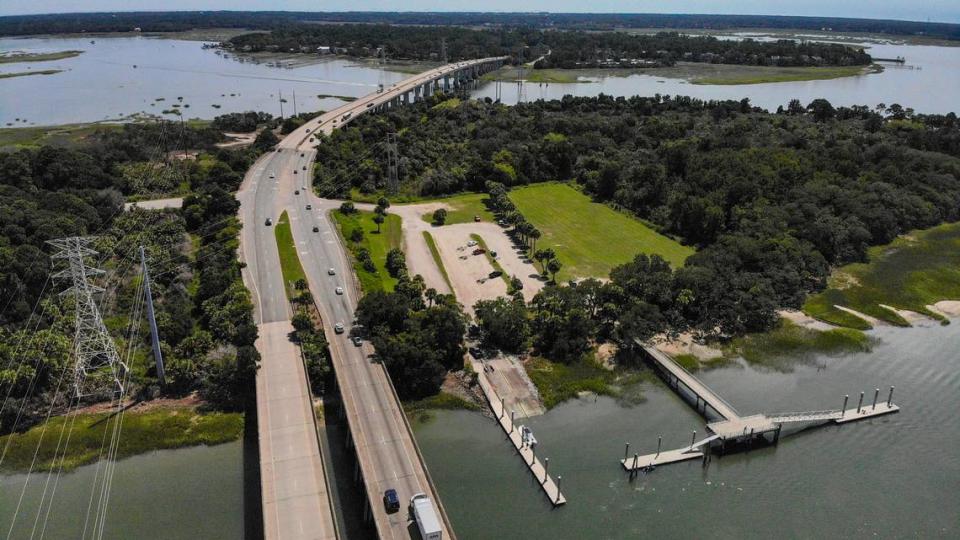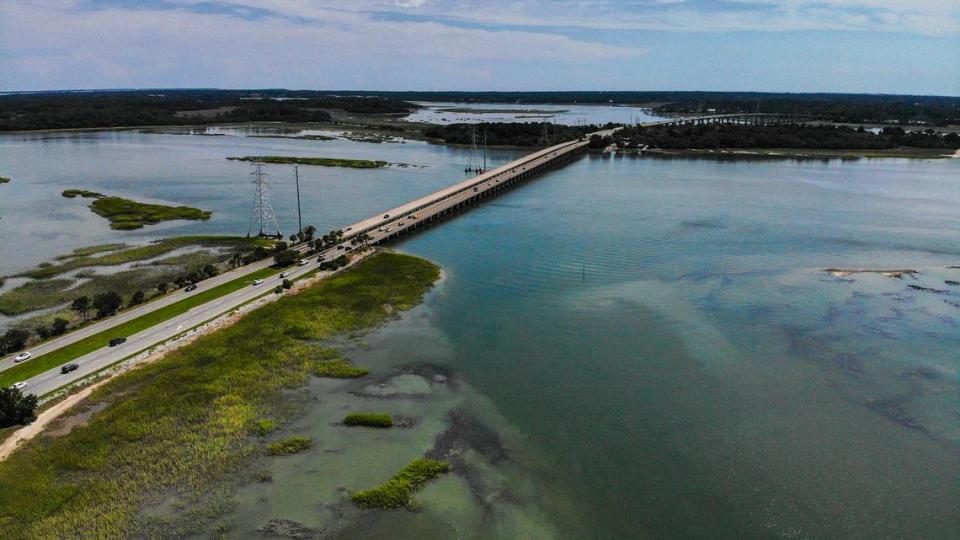Gridlock unstuck? Will Hilton Head’s U.S. 278 blessing fix commuting woes or raise more questions?
After seven years and countless hours of backups on the bridges to Hilton Head, the town agreed to move forward with a plan to ease traffic flow and the frustrations of island residents, workers and tourists.
The U.S. 278 Corridor project, replacing the bridges between Bluffton and Hilton Head Island with one six-lane bridge, is set to move forward, which was determined by a series of town council votes June 28. The town gave the state and Beaufort County permission to overhaul U.S. 278 within town limits with not-binding expectations, including reducing the speed limit from 55 mph to 40 mph and building two pedestrian overpasses.
The town gave the go-ahead, which is called municipal consent, in a 5-2 vote with Council members Patsy Brison and Tamara Becker voting against it. Council added their expectations in a 6-1 vote with Becker voting against it.
The Friday votes put in motion the process for the South Carolina Department of Transportation to get approval from the U.S. Army Corps of Engineers, solicit contractors and start construction on the project. South Carolina Sen. Tom Davis, R-Beaufort, estimated that ground-breaking will happen in mid-to-late 2025.
The vote ends years of discussion and debate between island residents, the county and the town over what the way on and off Hilton Head Island, by car, should look like. The discussion started about seven years ago when the South Carolina Department of Transportation first determined a section of the bridge was structurally deficient.
Four separate bridges connect Hilton Head to the mainland: one eastbound and one westbound over Mackay Creek, and another set between Pinckney Island and Jenkins Island over Skull Creek.
In recent months, the discussion focused on whether the entire corridor project should move forward or whether the SCDOT should solely address the structurally deficient bridge section, with the potential for repair or replacement. The first eastbound bridge over Mackay Creek is safe to drive, but SCDOT recently rated the structure and substructure as “poor.”
Those against the U.S. 278 project, including Becker, said that a bigger bridge would negatively impact the island’s character and quality of life for islanders, especially those living in the Big Stoney Historic Gullah Neighborhood. Becker argued that the consultant-assessed, 15-minute difference in commute isn’t worth the bridges’ overhaul.
Proponents of the project said it is necessary to address long commute times, traffic, emergency evacuation preparation and the growing number of people who work on the island. Council member Alex Brown said he couldn’t understand how someone could be against the town’s suggestions because they help the Gullah community with $10 million toward Big Stoney improvements including the overpasses.
“I will be supporting this because it is a chance for us to get it right,” Brown said, referencing the prior and present injustices to the Stoney Community, such as U.S. 278 cutting through the neighborhood. “There’s a chance for us to repeal what has been done in the past.”
Within the first 10 minutes of the meeting, Becker made a motion to postpone voting. Becker made the same motion again before the municipal consent vote. Neither motions were voted on because no town council member seconded it. If the town didn’t move forward with the vote Friday, it would have had the same effect as a “no” vote, meaning SCDOT would abandon the larger project and solely fix or replace a section of the bridge.
Though the town council moved forward with the vote, it made last-minute changes that caused some confusion.
‘Confusing’ changes to municipal consent
Before the town voted to give municipal consent, it voted to amend the municipal consent agreement to exclude conditions such as speed limit and lane width, meaning that the conditions aren’t binding.
“It is confusing,” Brison said. “We still have conditions, it’s just in a different form.”
The action was spurred by a June 27 letter from S.C. Secretary of Transportation Justin Powell explaining that SCDOT requires a “clean municipal consent resolution consistent with the standard template without further stipulations.”
In the 4-3 vote to change the municipal consent so that the conditions weren’t included in it, Becker, Brown and Brison voted “no.”
The last-minute change caused concern from some, exasperated when the town attorney said he didn’t know what would happen if the state and county didn’t follow the conditions.
“We have no guarantees on any of this,” Becker said of the conditions. “And here we sit ready to give municipal consent to the South Carolina Department of Transportation to build the bridge on a plan we don’t even know (much) of what entails.”
Other council members and Davis expressed confidence that the county and state will follow the conditions.
“There is a tremendous amount of goodwill,” Davis said of Powell and Beaufort County Chairman Joe Passiment and. “I’m not worried.”
Davis also said he was confident that the project would get the necessary funding.
Cost and next steps
The project cost is an estimated $460 to $480 million, according to Davis. He said about $300 million of that funding was secured between Beaufort County, the South Carolina Transportation Infrastructure Bank and SCDOT.
“Based on the most recent estimate, you’re looking at having to get another $160 or $170 million to complete the project,” he said, explaining that it would in part be his responsibility to secure that funding. “We have to go to existing sources to make up that shortfall.”
Specifically, Davis mentioned Beaufort County’s upcoming penny sales tax that is up for a vote in November’s elections. If that doesn’t pass, Beaufort County could use its bonding capacity. He also mentioned the SCDOT increasing its contribution.
There are other steps other than funding essential for the project to move forward. The U.S. Army Corps of Engineers must issue a “Finding of No Significant Impact” (FONSI) for the project’s Environmental Assessment.
“In other words, the next step is determination whether or not the project can move forward based on the environmental assessment that’s happened so far, or whether a more detailed environmental impact statement is required,” Davis said.



